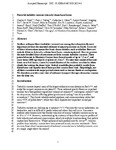Powerful turbidity currents driven by dense basal layers
| dc.contributor.author | Paull, C | |
| dc.contributor.author | Talling, P | |
| dc.contributor.author | Maier, K | |
| dc.contributor.author | Parsons, D | |
| dc.contributor.author | Xu, J | |
| dc.contributor.author | Caress, D | |
| dc.contributor.author | Gwiazda, R | |
| dc.contributor.author | Lundsten, E | |
| dc.contributor.author | Anderson, K | |
| dc.contributor.author | Barry, J | |
| dc.contributor.author | Chaffey, M | |
| dc.contributor.author | O'Reilly, T | |
| dc.contributor.author | Rosenberger, K | |
| dc.contributor.author | Gales, Jenny | |
| dc.contributor.author | Kieft, B | |
| dc.contributor.author | McGann, M | |
| dc.contributor.author | Simmons, S | |
| dc.contributor.author | McCann, M | |
| dc.contributor.author | Sumner, E | |
| dc.contributor.author | Clare, M | |
| dc.contributor.author | Cartigny, M | |
| dc.date.accessioned | 2018-10-09T11:25:00Z | |
| dc.date.issued | 2018-10-05 | |
| dc.identifier.issn | 2041-1723 | |
| dc.identifier.issn | 2041-1723 | |
| dc.identifier.other | 4114 | |
| dc.identifier.uri | http://hdl.handle.net/10026.1/12478 | |
| dc.description.abstract |
Seafloor sediment flows (turbidity currents) are among the volumetrically most important yet least documented sediment transport processes on Earth. A scarcity of direct observations means that basic characteristics, such as whether flows are entirely dilute or driven by a dense basal layer, remain equivocal. Here we present the most detailed direct observations yet from oceanic turbidity currents. These powerful events in Monterey Canyon have frontal speeds of up to 7.2 m s−1, and carry heavy (800 kg) objects at speeds of ≥4 m s−1. We infer they consist of fast and dense near-bed layers, caused by remobilization of the seafloor, overlain by dilute clouds that outrun the dense layer. Seabed remobilization probably results from disturbance and liquefaction of loose-packed canyon-floor sand. Surprisingly, not all flows correlate with major perturbations such as storms, floods or earthquakes. We therefore provide a new view of sediment transport through submarine canyons into the deep-sea. | |
| dc.format.extent | 0-0 | |
| dc.format.medium | Electronic | |
| dc.language | en | |
| dc.language.iso | en | |
| dc.publisher | Nature Publishing Group | |
| dc.subject | Geologic Sediments | |
| dc.subject | Nephelometry and Turbidimetry | |
| dc.subject | Pacific Ocean | |
| dc.subject | Water Movements | |
| dc.title | Powerful turbidity currents driven by dense basal layers | |
| dc.type | journal-article | |
| dc.type | Journal Article | |
| dc.type | Research Support, Non-U.S. Gov't | |
| plymouth.author-url | https://www.ncbi.nlm.nih.gov/pubmed/30291228 | |
| plymouth.issue | 1 | |
| plymouth.volume | 9 | |
| plymouth.publication-status | Published online | |
| plymouth.journal | Nature Communications | |
| dc.identifier.doi | 10.1038/s41467-018-06254-6 | |
| plymouth.organisational-group | /Plymouth | |
| plymouth.organisational-group | /Plymouth/Faculty of Science and Engineering | |
| plymouth.organisational-group | /Plymouth/Faculty of Science and Engineering/School of Biological and Marine Sciences | |
| plymouth.organisational-group | /Plymouth/REF 2021 Researchers by UoA | |
| plymouth.organisational-group | /Plymouth/REF 2021 Researchers by UoA/UoA07 Earth Systems and Environmental Sciences | |
| plymouth.organisational-group | /Plymouth/Users by role | |
| plymouth.organisational-group | /Plymouth/Users by role/Academics | |
| dc.publisher.place | England | |
| dcterms.dateAccepted | 2018-08-20 | |
| dc.rights.embargodate | 2019-12-14 | |
| dc.identifier.eissn | 2041-1723 | |
| dc.rights.embargoperiod | Not known | |
| rioxxterms.version | Accepted Manuscript | |
| rioxxterms.versionofrecord | 10.1038/s41467-018-06254-6 | |
| rioxxterms.licenseref.uri | http://www.rioxx.net/licenses/all-rights-reserved | |
| rioxxterms.licenseref.startdate | 2018-10-05 | |
| rioxxterms.type | Journal Article/Review |


